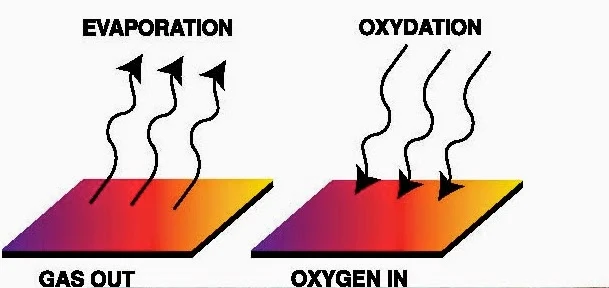The
inspector should be familiar with the types of curing mechanism of the coating
he is working with. He should also be familiar with the correct curing and
should be sure to check the coating manufacturers published Product Data Sheets
for this information. A coating must be property of the applied coating cured
before it is top coated and before it is placed into service. Premature failure
will occur if the coating is top coated before the primer or intermediate have
sufficiently cured. The uncured coating, if top coated, may blister because of
entrapped solvents. This may result in lifting of coating film. Many coatings,
such as coal tar, epoxies, have maximum recoat times. If the coating cures
beyond the required period for top coating, the topcoat will not bound properly.
It is especially critical in the applications of tank lining that the coating
be sufficiently cured before being put into service. A differentiation must be
made between “drying” and “curing. A coating may be dry to the touch and still
may not be cured.
Following
is the list of curing methods, together with the generic types of coatings
using each method.
Air oxidation
|
Alkydes, epoxy, Ester
|
Solvent Evaporation
|
Vinyls, Chlorinated Rubbers, Bituminous
(coal tar solution) Acylics.
|
Chemical reactions
|
Epoxies, Polyurethanes, Vinyl-Esters,
Inorganic Zincs, (Hydrolysis)
|
Heat Cure
|
Silicones, High Bake Phenolics
|
The
following is the description of each of the curing methods.
Coatings that cure by oxidation, or air drying, depends
upon oxygen to penetrate the film after the solvents has evaporated. There is
limit to the film thickness which can be achieved with this type of coating.
Alkyds are examples of coating that cure by this method. If they are applied
too thick, the solvent will evaporate from the surface, the oxygen will cure
the top layer of the coating film, and it will be difficult for the solvent to
evaporate from the lower layers of the coating. At the same time, oxygen will
have difficulty penetrating the rest of coating film, and the coating will not
cure properly.
Almost all coatings, unless they are 100 percent
solids, will undergo solvent evaporation prior to curing. The solvent
completely evaporates as the coating film curs, leaving the film of the resin
and pigments on the surface.
Coating that cure by the addition of a catalyst or
hardener, or coatings that are chemically cured, are usually packaged in two or
more containers, each container holding a carefully pre-measured amount of
material. These proportions are very critical and, for this reason only
complete units of any coating should be used. Do not attempt to proportion the
different components of a multicomponent coating. Unless a chemically cured
coating is mixed in the proper proportions and unless all the components are
used, it is highly unlikely that the coatings will cure properly. Once these
components are mixed together, the coating has a pot life, which refers to the
length of time the coating material can be used. Material should not be used
after its pot life has expired.
These coatings require heat curing to obtain maximum
stability and durability.









0 comments:
Post a Comment